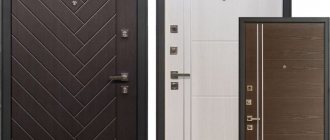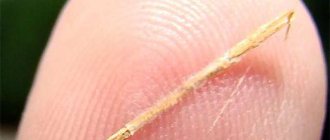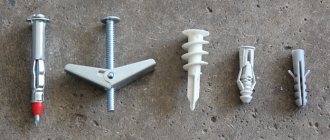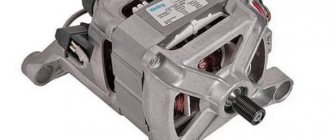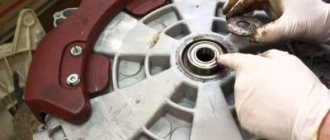“It doesn’t bark, doesn’t bite, and doesn’t let you into the house” - do you think this is a castle? But no! This is a broken key in the door lock. When you stand at a locked door with a piece of debris in your hands, the situation seems hopeless. Don’t rush to despair; for those who are friends with their neighbors, everything is not as bad as it seems. If the key in the lock is broken, you can still fix it.
If the key is broken, then the first thing you need to do is pull out the remains of it, and then, if there is no second key, pick the lock.
Assessing the situation
First of all, you need to stop panicking and assess the situation sensibly:
- if you have absolutely no skills in handling a lock , then in most cases it will be better to wait a little for the technician than to try to do something on your own and only make the situation worse;
- if you know something about the design of locks or even once installed or changed a lock yourself, then you can try to do it on your own;
- if time is short, even the most inexperienced person will try to do something on their own - it’s in our blood, so there’s no point in stopping you - we’ll just direct your efforts in the right direction so as not to make things worse;
- Be prepared for the fact that if the apartment is closed, you will have to turn to neighbors or friends for some tools. If the key gets stuck when the door is open and there is access to the apartment, then all the necessary tools can be found at home. And in general, when the apartment is open, you can act much more boldly and certainly try to solve the problem yourself before turning to the master;
- If you managed to remove the key, then you should not rush to insert it back and try again to open or close the lock.
The key in the lock is broken, what should I do?
Many online resources offer a wide variety of ways to open a broken lock, but few prescribe the sequence of actions in a given situation. After only half of the key is in their hands, many begin to take out their anger directly on the door itself, not thinking that with each blow the key can fall further and further, making further manipulations to remove it in vain. At least once in their life, every person has experienced something like this, and it’s not a matter of mishandling the mechanism or buying a low-quality product, it’s just that each mechanism has its own service life.
This rule also applies to locks, but few people remember this before a similar situation occurs. But before calling a door repairman, you should resort to the simplest, and therefore most common, methods of removing a broken key from a door mechanism. You can use simple tips from specialists who will help solve the problem within the next 10-15 minutes.
Removing a broken key from a lock using pliers
Rudeness and aggression directed at the door will not help the current situation, so the first thing to do is to stop panicking. Before breaking, the key will turn as usual, and pressing hard can dislodge the internal secretion and make removing the key difficult. When you try to put pressure on a stuck key, it breaks.
Some ways to remove a broken element:
- A regular fish hook may come in handy. It will not only allow you to get the fragment out, but also leave the very core of the castle intact. The remaining part of the key in the opening is carefully picked up with a hook, but the process will require a lot of patience and, most likely, free time.
- Brass tubes and a blowtorch. The tube is carefully inserted into the well close to the key (to what is left of it), after which it is heated with a soldering iron. The material becomes sticky, which allows you to pick up the desired element and easily pull it out.
- Jigsaw or nail file. This tool will allow you to saw off the key so that you can grab it by the edge. If the actions lead to success, then the remains should be pulled out extremely slowly. This is done to prevent debris from getting inside the locking mechanism.
- Using an awl. To do this, you will need two tools with which to pick up the key. Using the rocking method, the fragment moves from side to side. Before removing it, it would be a good idea to lubricate the opening with machine oil or other anti-corrosion compound.
A lot will depend on the type of keyhole. If the above manipulations do not give the desired result, then it is better not to delay calling a specialist.
Useful tools
The following tools are used:
- cutting part of a jigsaw;
- screwdriver and self-tapping screw;
- two awls;
- pliers;
- neodymium magnets;
- hammer and vibration method;
- brass or copper tube.
Jigsaw cutting part
If the key in the lock is broken, you will have to think about how to get it out. The use of a jigsaw is also a gentle method. The blade of the tool is inserted into the cylinder (into the gap under the protruding piece of the key). After this, the jigsaw needs to be turned so that its teeth come up. When in contact with the teeth of the tool, the fragment can be pulled out.
Using self-tapping screws
Self-tapping screws are much easier to find than a jigsaw. They are used in the case of thick key fragments. Using a drill, screw a self-tapping screw into the broken part of the key, and then remove the fragment. Pulling is done with a little force - so that the remainder comes out without damaging the secret mechanism of the lock.
Two awls
You can remove a broken key using an awl. To do this, carefully insert two thin awls into the gap between the fragment and the hole. Slowly swinging the rest of the key, remove it from the cylinder.
Pliers
Pliers are effective if the piece extends beyond the grub and can be grasped firmly. Carefully grab the protruding part of the fragment with pliers and gradually pull it out. Before working, you can pour a little oil into the keyhole.
Neodymium magnets
Neodymium magnets are not highly effective, but sometimes they help to remove a broken key from the front door lock. You need to apply a magnet to the fragment and try to pull it out. If the attempt is unsuccessful, other methods are used.
Using vibration
The vibration method is used only for disc type locks. The pins are lubricated and moved so that they are in the same position with the key fragment. After this, the lock is lightly hit with a hammer (from the opposite side). Sometimes the vibration knocks the rest of the key out of the cylinder, and it remains to be pulled out using any tool.
Removing the fragment from the lever lock
If the key in the lever lock breaks, you will have to use a brass or copper tube. The key to a lever door lock looks like a rounded pin in the shape of a cylinder. The main thing is to choose a tube that is suitable in diameter.
Important!
The length of the tool should be the same as the fragment remaining in the hand.
When putting the tube on the fragment, it should not go inside easily, because it will be impossible to fix the rest of the key.
Solution
Tools for removing a broken key: screwdrivers, awl, hammer, pliers.
Two types of methods are used to solve the problem. The first involves removing an object, and the second involves breaking the door lock.
There is a possibility that even after the successful use of one of the preserving methods, destructive ones will still have to be used.
This may be necessary when there is no second key or when the key in the lock is broken due to the failure of the code mechanism, and normal opening is impossible.
Saving methods
You need to start by pouring lubricant into the keyhole of the door.
To be sure, you should wait about 20 minutes. so that the lubricant penetrates the joints of the mechanism and the key that has broken in the lock.
In the simplest case, if the key in the lock breaks so that its core protrudes slightly from the hole, you need to try to carefully but firmly grab the end of the fragment with pliers. Rocking the clamped instrument in a circular motion and from side to side, pull it towards you. If you managed to get it, then you were lucky.
In a situation where the key in the lock is broken and you can barely see it, you can try using tweezers instead of pliers. The sequence of actions remains the same. Due to the fact that it is difficult to grasp well with tweezers, these manipulations have less chance of success.
For a disk mechanism, before removing the fragment, you need to use a thin screwdriver or a pin to turn all the code elements and the fragment itself counterclockwise until it stops. They must line up in the tunnel. Next, lightly tapping the back of the screwdriver on the end of the cylinder creates vibration in it, which promotes the movement of the debris to the exit. It should move to a more comfortable position for gripping.
Scheme for removing a broken key.
For steel keys, using a magnet may help. You can check the magnetism of a material by looking at its residues. The magnetized end of a good professional screwdriver will do. The cheap Chinese one has too little gravity.
A jigsaw blade can provide good fixation. You need to first break off the fastening end. The blade is wound along the rod with the teeth towards it and with the teeth sloping towards themselves, turns with the hooks towards the object being removed and is pulled out. This is done several times until a positive result.
If there is no such result, there is one last way to save the code mechanism. Provided that the key has broken in a fairly massive section, and there is an area of at least 2*2 mm on the broken part, you can try drilling a hole with a diameter of 1.5 mm in it and screwing a self-tapping screw into it. As the edge of the hardware sharpens from the hole, the fragment is loosened and removed.
Types and characteristics of locks
Classification of locks
The following types of locks are distinguished:
1. By type of fastening:
- Mounted. These are locks, the fastening of which is carried out by threading the bow into the eyes. Padlocks are easy to install and replace. However, they have rather low burglary resistance. Scope of application: sheds, warehouses, basements, garages.
- Mortise. These are the most commonly used locks, installed directly inside the door leaf. It is advisable to embed them into metal doors, where they are protected from drilling by a sheet of metal. The locking mechanism must have high resistance to tampering, secrecy, reliability and durability.
- Invoices. Installed on the surface of the door leaf. Can be used for wooden and metal structures. They are characterized by ease of installation, repair and replacement, but they are not sufficiently resistant to hacking attempts.
2. By type of locking mechanism:
- Crossbars (rack and pinion). Inside them there is a crossbar with teeth and machined grooves. These locks have low burglary resistance, so their use to protect valuable items is not recommended.
- Level ones. This is the most reliable type of lock with a secret part in the form of plates (levers). The larger the lever, the more reliable the lock (preferably 6-8). Often, lever locks can be combined with other security systems.
- Cylinder. The design of the lock includes a mechanism consisting of a cylinder, a cylinder and a lever mechanism. Cylinder locks are characterized by high reliability. They are single- or double-sided, single- or double-row.
- Code ones. Used to protect gates, access doors and interior spaces. They do not require a key, but due to their low security level their use is limited.
- Electromechanical. They are similar in design to traditional mechanical locks, but can be opened and closed remotely. They can be mortise or overhead.
Extraction methods
Methods for extracting key fragments are divided into three main types:
Gentle , during which the metal fragment is removed without damaging the lock mechanism;
Damaging . The main task of this method is to disassemble the lock. In most cases, after disassembling the lock, the cylinder with a jammed or broken key is replaced, after which the mechanism is assembled and installed in the door without any problems. But there are some locks that either cannot be reassembled or cannot be disassembled. In this case, you will have to install a new mechanism;
Breaking . They are used in situations where it is impossible to disassemble the lock without damaging the door leaf. Therefore, after breaking it out, it is necessary to change not only the locking mechanism, but also the fittings, and also, in some cases, the entire door.
Gentle methods
The least dangerous situation for you to gain access to your apartment is when the key remains intact, but is simply stuck in the door lock. It must be carefully pulled out without damaging the pins inside the secret. The most common reason in such cases is a mechanism clogged with dirt. In order to get the key, you just need to clear away the accumulation of dust. To do this, you need to lubricate the lock with one of the following products:
- WD-40;
- machine oil;
- grease;
- liquid silicone;
- lithol.
Just like a stuck key, it will be easier to pull out a broken piece if you lubricate the lock a little.
As a last resort, take sunflower oil and pour it inside. It is very convenient to do this with a syringe. You need to literally wash the core. When the key is stuck in the lock, you cannot make sudden movements, carefully turn it with slow loosening movements and pull it out. If your hands slip, you can use pliers.
Sometimes the mechanism is blocked by broken parts inside the well. In this case, you need to lift the locking part using a pin or pin and release the key.
But how to get exactly the key fragment out of the door lock? To carefully open the apartment and not damage the mechanism, you can use the following methods:
- Oil. The principle of operation is the same as with a whole key. You can use tweezers or pliers to grab it if the protruding edge allows you to grab it with the tool.
- Jigsaw. This is one of the most effective and popular methods. Not the entire tool is used, but only its cutting part. The blade is pushed inside the core under the key and carefully turned so that the teeth are on top. Thus, you need to pick up the fragment and, through contact with the teeth, pull it out.
- Self-tapping screw. This option is only suitable for thick debris. Using a drill, a hole is drilled in the scrap and a self-tapping screw is screwed inside. Next, you need to grab it with pliers and pull it out along with the broken part.
- Vibration. This very unusual method is suitable primarily for the disk mechanism. First, you need to thoroughly lubricate the pins and move them together with the fragment to one position. Then hit the lock with a hammer on the back side and, under the influence of the vibration created, the key should come out a little. Then pick it up and remove it with pliers.
To remove a broken key from a lock, you can try various methods.
How to remove a key stuck in a keyhole
So, regardless of the reasons, there is a consequence - a stuck key that does not want to come out. All that remains is to choose the extraction method.
Recommendation. Before removing the broken key from the cylinder, lubricate the well with penetrating lubricants or “liquid keys”.
We use locksmith picks
They are sold in many construction stores; in extreme cases, you can buy them online.
You need to proceed according to the following instructions:
- There is always a gap between the key and the well. You need to press the rough wire into it to the maximum and pull it towards you.
- If it doesn’t work, try loosening it a little with a crochet hook. In this case, the pins should loosen a little and move.
Don't miss: Ways to open Metacom intercom without a key
- Then repeat the procedure with the wire.
The main disadvantage of this method is that you must constantly carry a set of master keys with you, which can cause confusion among law enforcement officials.
In addition, in cheap kits the wire is very flimsy and can break, blocking the only access to the well.
Using eyebrow tweezers
The broken key can be removed from the lock cylinder with microtweezers. Most “English” type locks have a small recess near the hole, but it is enough to get caught.
In this case, lubricate the slot with a large amount of WD or any “liquid key”. Grab the protruding piece with the tips of the tweezers and pull it towards you. Loosen it to the sides to make it “go easier.”
The self-tapping screw comes into play
If the key in the lock is broken and you can’t grab it, a self-tapping screw will help. In this case, you will need to screw it between the wall and the fragment. Then grab the head of the screw with pliers and pull it forcefully towards you.
There are two possible solutions here:
- The self-tapping screw will pull out the fragment thanks to the thread. This rarely happens, because... it is easier to pull out the entire larva. This is especially true for cheap Chinese locks.
- The fragment will remain in the well, but the hollow will widen. Then it can be hooked.
With a knife
How to get a fragment if there is nothing at hand? Try a universal household tool - a knife, or maybe 2.
In this case, friction is used: press the tip against the free edge and try to pull out the fragment.
You can also use two knives. Then the extraction will be more effective.
The main thing is not to try to insert the knife deep, otherwise the tip will simply bend. This happens especially often with kitchen knives, because... they are made of thin steel.
Fishing hook
An ambiguous method, because Works exclusively with padlocks. You will need a good spring steel fishing hook.
It is necessary to hammer it into the hollow, and use pliers to press on the free edge. The principle of operation is the same as with a knife, but a slightly different shoulder is used.
The main disadvantage is that it is very inconvenient to fix the hook.
We use a drill
An even more controversial method, because may not only not help, but also aggravate the situation. You will need a good metal drill and a drill.
Don't miss: Combination locks for interior and exterior doors, mechanical combination locks
Just drill the key and the hole about a centimeter.
Then tilt the drill a little and pull it out along with the fragment.
There are quite a few disadvantages here:
- If the drill is not sharp enough, you can wedge the fragment in the well, after which it will be impossible to get it out.
- With strong pressure there will again be wedging.
- If the hole is not strictly perpendicular, it will be impossible to get the key.
We use thin fabric
You can use a hacksaw blade to make a brush that will help remove the residue. To do this, cut it on one side with metal scissors. The width of the pick should be about 4 mm.
You need to insert it into the hollow and pull it out sharply. You can help yourself with pliers. If the canvas is good, then you can loosen the pins with the help of no foreign objects.
Shoe awl
It is used for darning shoes. It consists of a thin rod and a small hook at the end. It is necessary to insert the awl as deep as possible into the hollow and try to catch on any protrusion. Then pull sharply towards you.
Super glue
In case there is nothing else at hand. This will require second glue (usually they are made on the basis of cyanoacrylate) and some kind of base (you can use a broken section of the key) that is left in your hands.
It is necessary to apply glue to it and sharply press it against the fragment in the well. In doing so, follow a few rules:
- Don't pour too much glue. In this case, you can accidentally stick to the lock itself.
- Act quickly because... The glue dries very quickly.
- Wait until completely dry. Here the situation is similar: the glue may not dry out, as a result of which the connection will be fragile.
After drying, carefully remove the key. Any second glue does not hold up well to breaking, so there is no need to make perpendicular movements.
Please note that the method is effective only if the edges of the break are smooth and without burrs. Otherwise the grip will be uneven. Also, the method is ineffective if the key is made of silumin. It is a metal powder that remains grainy. It is difficult to adhere smoothly, and the gluing will be weak.
Don't miss: How to open an interior door without a key
Removing the lock by removing the cylinder
It happens that gentle methods do not help and you have to completely remove the larva. There are proven “barbaric methods”, after which a complete replacement of the door lock is necessary:
- knocking out the cylinder. There is an armor plate on the back of the door. It needs to be removed along with the screws and hit with a hammer on the protruding part of the cylinder;
- prying the core. It is pryed off with an awl, a thin screwdriver or a hairpin. Using any tool, you need to lift the pins in the secret mechanism and release the rest of the key;
- drilling out the cylinder. It is drilled over the keyhole, turned and removed;
- removing the lock from the end. The method is used with the door open, when the key fragment does not protrude from the hole. The lock is removed and taken apart.
Methods involving removing/damaging the lock
If it is impossible to remove the fragment, the following basic methods are used:
- Pulling out the lock cylinder. The following algorithm of actions is provided: the end of the cylinder is clamped with a gas key and rolled up, and then the locking mechanism is opened with a screwdriver. If the larva cannot be removed, you must first remove the decorative trims and return them after replacing the larva.
- Prying the core. Using an awl or pin, you can pry off the lock cylinder. The tool is inserted into the keyhole, then the bolts of the secret mechanism are raised. You need to work more carefully, otherwise there is a risk of damaging the lock.
- Drilling the cylinder. It is possible to drill out the cylinder mechanism using a drill. Then it turns a little and is removed from the door.
- Knocking out the lock. The cylinder can be knocked out with a hammer after first removing the armor plate. However, in this case the lock will need to be replaced.
- Dismantling the lock. You can disassemble the lock into parts after removing it from the door leaf. This method is highly reliable. However, it can only be realized if the door is open.
The lock can be removed to remove the key.
Aggressive methods
There are a number of ways to remove a broken key from the cylinder, but at the same time damaging the integrity of the lock. They should be used if other methods do not bring the desired result. Main methods:
- Removing the larva. Remove the decorative trim, and then clamp the protruding part of the lock cylinder with a gas key and turn it. Use a screwdriver to open the mechanism and completely pull out the cylinder. After these manipulations it will need to be replaced.
- Drilling the cylinder. Drill out the cylinder mechanism with a drill, the thickness of which should be selected depending on the size of the lock. Turn it slightly with pliers and pull it out along with the broken key.
- Knocking out the lock. Remove the decorative trim and then apply a chisel or similar tool. Give several blows with a hammer until the cylinder falls out from the back of the door.
If the door can be opened, then to remove the fragment, the lock can be completely disassembled and then a new cylinder can be installed. To avoid unpleasant repairs to the lock, it should be lubricated regularly and dirt should be removed in a timely manner. It is important to always insert the key as carefully as possible and avoid using low-quality blanks when creating a duplicate.
Rough
If the key breaks in the lock, and gentle methods and disassembly of the locking mechanism are impossible, you will have to use brute force. So how do you open the door in such a situation?
The first method is to press the sash. To do this, one edge of a crowbar or pry bar is inserted into the gap between the frame of the door block and its leaf. Pressing the second end acts as a lever to open the door. Often, after releasing, the lock is damaged, in some cases the sash may be damaged.
The second method is to cut off the loops with a grinder. This is a quick and effective method to get into the apartment, but it is also expensive, since you will have to buy a new set of hinges. And on some models of entrance doors, awnings are quite expensive fittings.
It is also worth noting that modern anti-burglary systems on entrance doors eliminate the possibility of pressing, sawing off hinges and drilling out locks. Accordingly, if the key breaks, you will have to call a specialist with certain skills and the required set of tools.
What to do with a key stuck in the cylinder
Do not think that only professionals can cope with such a task. Knowing the possible cause of the problem will help you solve it on your own in a short time. First of all, there is no need to become desperate or angry. Excessive force when trying to turn a key can cause it to break, and removing a broken key from a lock is much more difficult. Before calling the rescue service, you should try to use the means that are at hand, in the car or in your neighbors.
You can do the following:
- Place machine or vegetable oil into the cylinder or slot. In this case, you need to constantly turn the key, feed it back and forth. The oil will soften dirt and rust. If the key has become slippery, you can grab it with pliers, string or wire.
- Warming up the castle. This technique helps melt ice or frozen grease. To warm up, it is better to use a turbo lighter. To avoid damaging the door trim, you need to cover it with a stone, a piece of tile or plaster.
- Lift the door a little and try to turn and pull out the key. If there is a misalignment, this will be easy to do. After this, you should move the bar or widen the holes in it with a file or drill with an abrasive attachment.
- Remove the larva. This can be done provided that the key turns. First, the fixing bolt is unscrewed, then after a slight turn of the key, the cylinder is pulled out. After such manipulations, it is necessary to insert a new core or completely change the lock.
- Drill out the inside of the larva. It is advisable to use a powerful drill with a good metal drill bit. A screwdriver is inserted into the resulting hole, with the help of which the cylinder is removed from the hook with the lock body.
It is not recommended to hit the key and lock when trying to open the door. Excessive force compromises the integrity of the mechanism.
How to get a key if it is broken in the lock
This usually happens with worn cylinder locks. The well there is narrow, and the key is flat, so if you overdo it in dealing with a jammed mechanism, it will only get worse.
First of all, you should try to open the door with the rest of the key. To do this, you need to push it all the way into the slot, and then insert a nail file or other thin object and try to turn it, opening the lock.
If the key is broken so that part of it sticks out of the hole, you are in luck. The fragment is quite easy to remove using pliers or a similar tool. Borrow it from your neighbors and carefully pull out the rest of the key, firmly grasping the part sticking out.
You can also try turning the key and opening the lock.
Didn't it work out? Well, then you'll have to get a jigsaw file. It must be inserted into the keyhole on the side of the key, with the teeth pointing towards you.
When the file enters the slot all the way, turn it 90 degrees to pick up the key and try to get it out.
Another option is to remove the remains of the key by gluing the broken part to it. Carefully apply superglue to the broken area and connect both parts.
Wait a little while for the glue to dry and try to slowly remove the key from the hole.
Application of lubricants
Lubricants will be effective if the key does not break off, but remains intact.
Gentle methods include the use of various lubricants. They can be effective if the key has not broken off, but remains intact and cannot be removed by hand. The main thing is to carefully remove it from the lock cylinder, without damaging the pins inside the secret mechanism. A common cause of the problem is dirt or foreign objects getting inside the larva. Lubricant will help clean the well and remove dust. You can use machine or sunflower oil, WD-40, liquid silicone, lithol or grease solution.
Advice!
Pour the liquid inside the cylinder with a syringe to rinse the lock core and remove the key.
Perform all actions carefully: first try to quietly loosen the key and only then remove it from the cylinder. The movements must be slow, otherwise it may break off. Usually, pulling the key out quickly occurs if the secret mechanism is not broken. If internal elements break, they are lifted with a hairpin or pin.
Ways to remove the key
First, try “soft” ways to remove a broken key from a lock.
To begin, lubricate the core of the larva with any available means - grease or oil, preferably machine oil, but if this is not available, even sunflower oil will do. It is convenient to do this with a syringe. After dripping several times, wait 10-15 minutes for the oil to spread inside the mechanism. After this, take tweezers or thin pliers and try to remove the protruding fragment. Assess how deeply it is embedded, and keep in mind that you should not use force - this can damage the lock and complicate the task.
If the key is stuck in the padlock
Attachment devices fail much more often than internal ones. This is due to the fact that they are in constant contact with the external environment. Vandals, thieves and petty hooligans have access to them.
If a problem arises with a padlock, then you can solve it in the following ways:
- Tap the lock with a hard object without touching the shackle. It is quite possible that a slight vibration will allow the movement of jammed parts to return.
- Pour machine oil into the slot. It reduces friction and eats away rust. Lubrication will ensure straightening of the compressed springs. In some cases, this occurs when corrosion has penetrated into all devices and mechanisms.
- Place the device in a container filled with a chemically active liquid. Gasoline, kerosene or acetone help well. These substances dissolve rust, oil and plasticine. If the desired result cannot be achieved immediately, then the lock is soaked for a long time. The process can take several hours if time permits.
- Warm up the lock well. If it is nickel-plated or made of stainless steel, then you can use an open flame - soot from the metal can be easily washed off. In the case where the product is painted or coated with polymer coating, you need to act carefully. The lock needs to be immersed in a container of hot water for a few minutes. If this works, it will need to be well dried and lubricated.
- Sawing off loops or bows. This is done using a hacksaw or grinder. Loops and bows can be cut quickly and silently with special cutters with long handles. Sometimes a gas or electric welding machine is closer.
If you don’t have the necessary liquids or tools at hand, then brute physical force comes to the rescue. Typically, a few hits from a sledgehammer are enough to break even the strongest lock. You need to hit it very carefully so as not to damage the door, floor or threshold.
Help from special services
If independent actions do not produce positive results, you will need to seek professional help. You can get it from the housing office or the management company servicing your apartment. Good specialists go to the site within an hour from the moment the application is submitted. First of all, they use gentle means, but if they are ineffective, they have to dismantle them.
When specialists arrive at the site, be prepared to provide them with identification documents. This could be a driver's license or passport if it was not in a locked room. If we are talking about a rented apartment, be sure to contact its owners and ask them to come with the appropriate documentation.
You will not have to pay any money for the service of calling a technician, since it is paid for by the management company. In particularly difficult cases, you will have to contact a commercial service and pay a small fee.
Some companies may offer a guarantee for servicing a new lock.
What to do with interior doors
In addition to entrance doors, interior doors are also susceptible to lock failure. If a tongue remains, they can be opened with any available device with a wide working part. To solve the problem, you can use a durable knife. With this tool you need to remove the tongue to instantly open the door.
If the latch is triggered at the wrong moment, a thin wire must be lowered into the lock hole. This will trigger the key and open the part.
There are other solutions that may be effective depending on the type of lock and door:
- A crowbar must be placed in the door gap between the door leaf and the frame. Under the influence of the device, the lock bolts will be put into action, after which the door can be opened without much difficulty.
- In case of particularly complex damage, the door hinge must be cut off with a turbine or grinder.
- If the door slams, use a simple bank or other plastic card. A similar option can be considered if there is a latch. The card is placed in the doorway. If the lock has a complex design, you will need to remove all the bolts.
It is prohibited to use heavy or sharp objects that could cause harm to remove the key. You cannot use thin wire to accomplish this task, because... it can scratch the metal surface and make the situation worse. Also, do not try to glue the product with “super glue”, since this is only a temporary solution and will not solve the problem.
Causes of key failure
There can be several reasons for the breakage of a product that is stuck in a door, both from the key and from the lock.
- The door has an old locking mechanism. Over a long period of use, it wears out and rust forms inside. This becomes an obstacle to smooth sliding during the opening process.
- Contaminants get inside the lock.
- The key was turned incorrectly or too sharply in the keyhole.
- The key is not inserted all the way.
- The owner is trying to open the door with a non-original product.
- Poor quality material from which the key body is made. For example, aluminum can bend even in a trouser pocket.
- The key is stuck in the door lock and they are trying to force it out using pliers and other tools.
When a situation like this happens, we think little about its cause. We need to open the door.
Sources used: dvervdome.ru, uborka-v-dome.ru, vseodveri.ru, optoring.ru, vodakanazer.ru, stroyudom.su, bestdoor.guru, hozsekretiki.ru, o-dveryah.ru, stroy-podskazka.ru , krrot.net, uborka.co, prodverivdome.ru
Main causes of failure
Which laminate or doors come first
? To open the lock of an interior door, you should first identify the cause of the breakdown. Typical reasons include:
- Jamming as a result of the gradual accumulation of dirt and dust or foreign objects entering the mechanism.
- The door lock mechanism is worn or damaged.
- The key is stuck in the door lock (this usually happens when using a low-quality duplicate or damaged key).
- The door was deformed due to moisture or warped as a result of improper installation.
- The key to a closed door is lost.
- The key in the lock is broken.
- The door handle broke off.
- The children accidentally locked themselves inside the room.
- The door slammed shut from a gust of wind, and the key remained inside the room.
Removing the door from its hinges
- Opening with an improvised master key.
- Removing the door from its hinges.
- Removing a lock or handle.
- Use of physical force.
